Wine, Beer, and Food Pairing: Pappardelle and Chardonnay
This month’s Wine, Beer, and Food Pairing features Line Chef Anthony Sorrentino from potager restaurant and wine bar (a local establishment with an over 20 year history here in Denver) presenting their Pappardelle entree with squash and tomato ragout, paired with a 2017 Jack’s Hill Chardonnay Le P’tit Paysan selected by Carolyn Joy of Joy Wine and Spirits.
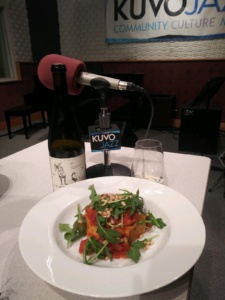

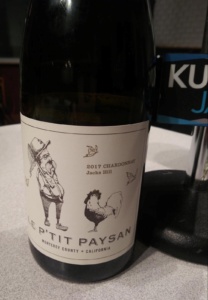
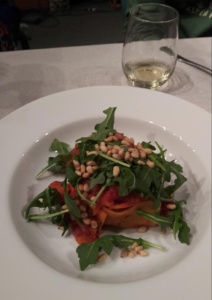
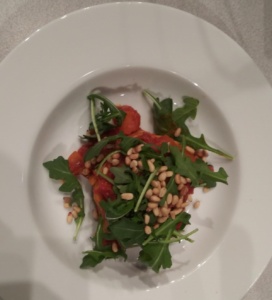
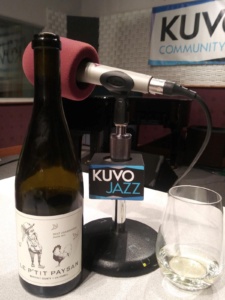
A NOTE FROM CAROLYN JOY
There are exceptions to every rule…..or at least that is what my teenage son proclaims, like the time he couldn’t finish his homework due to all the chores he had. While, “exceptions” may be an excuse for why homework wasn’t completed, exception, is a bonus in the wine world for this month’s KUVO wine and food pairing. All over the world, there are “no exception rules” in terms of area designations and classification systems that are supposed to help consumers differentiate one wine from another, and to determine quality. A uniform code of sorts that levels the playing field.
In France, their classification regulates not only area, but varietals and yields while the Denomination de Origen (DO) of Spain regulates origin, varietal and aging requirements. For example, in Rioja DO, Crianza, Reserva and Gran Reserva require specific aging in oak barrels before bottling where in Champagne AOP, yields per acre and even how close together the vines are planted are governed by the region’s laws but the “Reserve” term has no legal requirements.
There are two classification systems in the United States which are quite different than European systems. Appellation of Origin (AO) is defined by a political boundary, such as a county name. Federal law requires that 75 percent or more of grapes used to make the wine be from that appellation, and that the wine be fully finished within the state in which the county is located. Wine bearing “California” as an Appellation of Origin must, under state law, be made with 100% grapes that were grown and finished in the Golden State.
In the second classification system, the American Viticultural Area, (AVA), there are no regulations over grape varieties or yields for the area. The only restriction is that a minimum of 85% of the grapes labelled with an AVA must come from that region, and the wine must be fully finished within that state. Certain states have stricter standards for use of the name of an Appellation/AVA on wine labels such as Oregon which requires 100% AVA and 100% Pinot Noir if stated on the label.
Often in the US, we put more importance on varietal, than on place. Many of our customers might ask only for a varietal like Chardonnay, and not frequently ask for a white Burgundy (which the name alone denotes place and varietal, Chardonnay from the Burgundy region). But, at Joy Wine and Spirits, we are on the hunt for wines from different places within a state, that reflect the unique terroir of that area, or in this case, the unique area of a specific site, which may be different from all of its surrounding area! Confusing! I know!
So Le P’tit Paysan Chardonnay is this month’s exception to the rule. It is grown in Monterrey, where fertile farmlands and access to irrigation produce an abundance of celery, leaf and head lettuce, strawberries and broccoli. Grapes are grown more easily here and therefore most wine is more reasonably priced than dry farmed vines grown on rocky, hilly mountainsides that must be hand-harvested.
Ian Brand, winemaker for the Le P’tit Paysan wines, says on the impetus for his wines, “We did not set out to make these wines. We discovered great vineyards at the edge of sensible farming and decided to bring them to light. The farther we looked, the more we found – remote, challenging vineyards, with hard depleted soils, and intense sunlight tempered only by the coastal breeze. Vineyards capable of producing only the most idiosyncratic wines. Our goal as winemakers is to lightly polish the roughest edges and leave the idiosyncrasy intact. It is here in the back country, filled with individual character, where Le P’tit Paysan comes to life.”
In their growing sites Brand looks for shallow, rocky soils, good site selection and proper varietal match with the soil and climate. The often overlooked greater Monterey Bay Area has a plethora of underappreciated, rocky vineyards, many of which contain a high proportion of limestone…. all exceptions to most Monterrey appellation Chardonnay which can often be picked out by its signature trait of tropical flavors such as pineapple and their balance of both rich texture and a fresh finish from the Pacific fog that roles in at night.
Brand is known for his progressive approaches to plantings, commitment to organic farming and tireless promotion of Monterey as the next region to watch in California.” Come in tonight to discover this exceptional Chardonnay, a deep contrast to the buttery, rich Chardonnay often associated with California. Le Petit Paysan Chardonnay is layered in flavors, crisp, bright, and so compatible with many foods. Join us tonight in tasting this delight, also with the Petit Paysan Cabernet.
Become a Member
Join the growing family of people who believe that music is essential to our community. Your donation supports the work we do, the programs you count on, and the events you enjoy.
Download the App
Download KUVO's FREE app today! The KUVO Public Radio App allows you to take KUVO's music and news with you anywhere, anytime!



